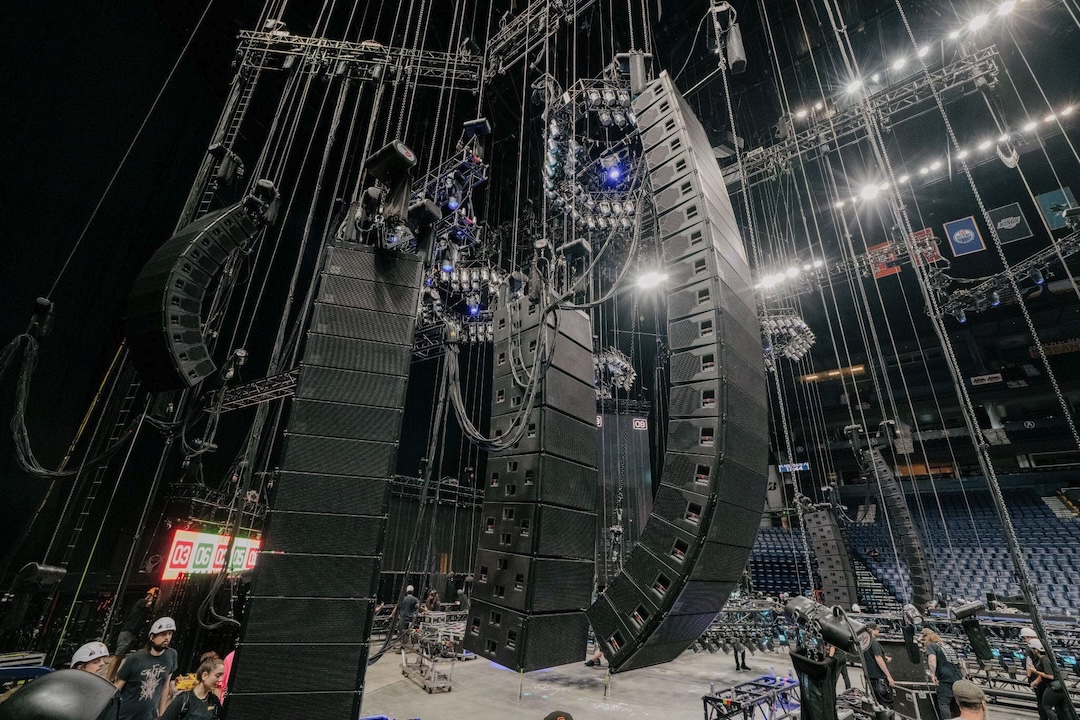St. Louis, MO (November 10, 2025)—Swedish heavy metal band Ghost is many things, but subtle is not one of them—and they wouldn’t have it any other way. Melding together hard rock, pop, theatrical production and old-fashioned shock value, the group is selling out arenas in an era where the concepts of ‘loud guitars’ and ‘hit albums’ seem to be mutually exclusive…unless you’re Ghost. Ensuring audiences hear every brutal note on the band’s current North American tour, due to resume in January, is Gateway Studios & Production Services (GSPS).
FOH engineer Nate Northway describes the task bluntly: “Arenas are challenging, reverberant spaces to begin with. Ghost is a nine-piece hard rock band and every element of the music is important. Carving out space for two guitars dripping in gain, two synth players, an eleven-piece drum kit, bass, three vocalists, and percussion can be very difficult in these cavernous rooms. The band can swing from delicate and dynamic to bold and bludgeoning in just a few bars, so I have to be equally focused on intelligibility and musicality throughout the set.”
With that in mind, GSPS has been supplying and deploying a d&b audiotechnik SL-Series system, including 20 GSL mains per side, 16 KSL side hangs per side, 12 KSL rear hangs per side, eight flown SL-SUBs per side, six ground SL-SUBs per side and d&b Y10 front fills.
Under system engineer Nils Knecht, along with P.A. techs Alex Dickinson, Nick Hime and Samuel Schmitt, and monitor assistant Danelle Stoltzfus, the Gateway team tailors every deployment to each arena’s unique acoustic signature. Northway observed, “Nils, Sam, Nick, and Alex really spent a lot of time making sure the entire 270 rig was even and balanced, even in the most challenging venues.”

Monitor engineer Paddi Krause notes the precision and discipline required to keep the onstage environment quiet and controlled; “I’m responsible for the entire monitoring side of the show, 103 inputs, 20 IEM mixes, and a stage loaded with open condenser microphones,” he said. “Every single dB not wasted or spilled back matters. Thanks to GSPS’s meticulous execution and d&b’s world-class system design, I’m operating in one of the quietest on-stage environments I’ve encountered. The result? Less noise, more art.”
Dan Malsch Mixes Milestone Ghost Album
For Northway, the Avid Venue mixing system remains the centerpiece of his mix workflow. “It just sounds incredible,” he said. “Add the ability to automate any parameter using just about anything you can think of as an event trigger, and you have the perfect platform.”
That adaptability proved essential when the production team introduced new stage elements mid-rehearsal, including a kabuki that temporarily obscured the main P.A. “Since the mains were the only part of the P.A. behind the kabuki, we measured the frequency response and created filters using the DirectOut Prodigy to match the sides and 270s,” Northway recalled. “Then, at the moment the kabuki drops, we triggered a bypass to mimic the drop across the entire system. It actually ended up giving the start of the show even more impact.”
Across departments, the collaboration has extended beyond audio. “Lighting, video, SFX, everything is designed to work in concert,” said Northway. “There’s a dramatic moment at the end of the second act where everything changes. Our contribution was to use the subs to devastating effect. It’s always fun to have an excuse to see what a P.A. is really capable of, if only for a few seconds.”
“Supporting a band like Ghost requires precision, creativity and a team that can execute at a world-class level,” said Paul Owen, VP of Business Development at Gateway Studios & Production Services. “Our crew, combined with d&b audiotechnik’s system design, allows us to deliver consistent, high-impact sound night after night, no matter the venue. It’s about more than just gear; it’s about people, planning and a commitment to excellence.”
This article originally appeared on Mix Online.